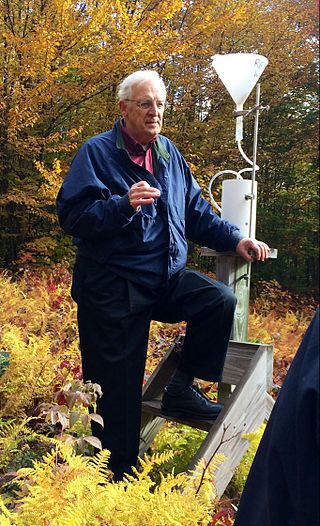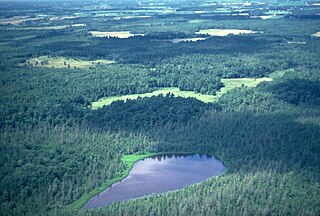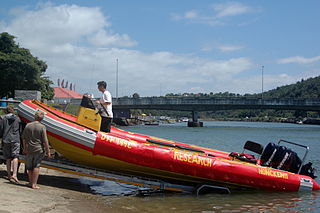History
Andrews Forest was named for Horace Justin Andrews, a forester. [8]
The history of the research program at the Andrews Forest has been diverse, with the dominant themes changing over time. Research emphasis in the 1950s and 1960s concerned effects of forest management (clearcutting, prescribed fire, roads) on streamflow, soil erosion, and water quality. [9] During the International Biological Program of the 1970s, basic studies centered on the workings of the forest and stream ecosystems, especially in old-growth forests. In the 1980s, these basic studies continued under LTER and were augmented with applied research in silviculture, wildlife, landscape ecology, carbon dynamics, and other topics. Conflict over federal forestry in the 1990s focused attention on old-growth, spotted owl, and landscape ecology. With growing concern about climate change in the 2000s, analysis of long-term records and effects of mountain topography on ecosystem response to climate variability took center stage.
Outreach
The Andrews Forest Program includes a very broad spectrum of outreach activities with multiple objectives and funding sources. The Education program provides an opportunity for undergraduate and graduate classes from regional and international schools to visit the forest for field courses, study tours and research experiences.
Innovative K-12 programs give teachers the experience and skills to lead authentic research projects with their students, and middle school students the unique opportunity to study the forest on the ground and in the canopy. The Andrews Forest is recognized as a leader in developing research-management partnerships in which insights and information flow in both directions, projects are undertaken jointly to development the scientific basis for addressing land management challenges, and broad communication of key findings is a priority. The Andrews Forest recognizes that science is but one way of knowing and actively promotes arts and humanities inquiry into the nature of forests, streams and selves through the LTEReflections program.
LTEReflections
Since 2002, the Andrews Forest has engaged poets, essayists, philosophers, religious scholars – in the Long-Term Ecological Reflections program jointly sponsored by the Forest Service Pacific Northwest Research Station and the Spring Creek Project for Ideas, Nature, and the Written Word [16] in the School of Religion, Philosophy, and History at Oregon State University. Raw data (e.g., journal entries) and published works of more than 40 writers in residence are posted on The Forest Log. [17] [18]
This work is part of a larger effort to encourage arts-humanities-environmental science collaboration across a network of about 20 sites and programs characterized by long-term, place-based work that collects, archives and actively disseminates the work of artists, scientists, and creative writers of many persuasions. [19]

Cascade Head is a headland and 102,110-acre (41,320 ha) United States Forest Service Experimental Forest and part of the World Network of Biosphere Reserves. It is situated 85 miles (137 km) southwest of Portland, Oregon on the Oregon Coast between Lincoln City and Neskowin. Cascade Head Preserve is a Nature Conservancy Selected Site.

Gene Elden Likens is an American limnologist and ecologist. He co-founded the Hubbard Brook Ecosystem Study at the Hubbard Brook Experimental Forest in 1963, and founded the Cary Institute of Ecosystem Studies in Millbrook, New York in 1983.
The Long Term Ecological Research (LTER) Network consists of a group of over 1800 scientists and students studying ecological processes over extended temporal and spatial scales. Twenty-eight LTER sites cover a diverse set of ecosystems. It is part of the International Long Term Ecological Research Network (ILTER). The LTER Program was established in 1980 and is funded by the U.S. National Science Foundation. Data from LTER sites is publicly available in the Environmental Data Initiative repository and findable through DataONE search.

The Konza Prairie Biological Station is a 8,616-acre (3,487 ha) protected area of native tallgrass prairie in the Flint Hills of northeastern Kansas. "Konza" is an alternative name for the Kansa or Kaw Indians who inhabited this area until the mid-19th century. The Konza Prairie is owned by The Nature Conservancy and Kansas State University.

National Ecological Observatory Network (NEON) is a facility program operated by Battelle Memorial Institute and funded by the National Science Foundation. In full operation since 2019, NEON gathers and provides long-term, standardized data on ecological responses of the biosphere to changes in land use and climate, and on feedback with the geosphere, hydrosphere, and atmosphere. NEON is a continental-scale research platform for understanding how and why our ecosystems are changing.
F. Stuart Chapin III is a professor of Ecology at the Department of Biology and Wildlife of the Institute of Arctic Biology, University of Alaska. He was President of the Ecological Society of America (ESA) from August 2010 until 2011.

The Cedar Creek Ecosystem Science Reserve is an ecological research site located primarily in East Bethel, Minnesota in the counties of Anoka and Isanti on the northern edge of the Minneapolis-Saint Paul metropolitan area.

Harvard Forest is an ecological research area of 4,000 acres (16 km2) owned and managed by Harvard University and located in Petersham, Massachusetts. The property, in operation since 1907, includes one of North America's oldest managed forests, educational and research facilities, a museum, and recreation trails. Harvard Forest is open to the public.
An experimental forest, or experimental range, as defined by the United States Forest Service, is "an area administered ... 'to provide for the research necessary for the management of the land.'"

DataONE is a network of interoperable data repositories facilitating data sharing, data discovery, and open science. Originally supported by $21.2 million in funding from the US National Science Foundation as one of the initial DataNet programs in 2009, funding was renewed in 2014 through 2020 with an additional $15 million. DataONE helps preserve, access, use, and reuse of multi-discipline scientific data through the construction of primary cyberinfrastructure and an education and outreach program. DataONE provides scientific data archiving for ecological and environmental data produced by scientists. DataONE's goal is to preserve and provide access to multi-scale, multi-discipline, and multi-national data. Users include scientists, ecosystem managers, policy makers, students, educators, librarians, and the public.

The South African Environmental Observation Network (SAEON) is a science network of people, organisations and, most importantly observation platforms, that perform Long-Term Ecological Research (LTER) in South Africa and its surrounding oceans. The SAEON is of global importance as an innovative approach in ecology to understand environmental change and to determine the impact of anthropogenic forces at multiple scales but it is a remarkably complex challenge to statistically discern between ubiquitous natural variability and exogenous forcing. The SAEON constitutes a national government response to the World Summit on Sustainable Development (Earth Summit 2002) and is a component of the GEO (Group on Earth Observations). The SAEON has become the leader in environmental science and observation in South Africa, but has been criticised for taking a long time to establish, a situation which was inevitable in view of SAEON's multiple stakeholder corps. It has also been raised that the cost of replicated experimental treatments across SAEON sites will be high.

Michael Paul Nelson is an American environmental scholar, writer, teacher, speaker, consultant, and Professor of environmental philosophy and ethics at Oregon State University. Nelson is also the philosopher in residence of the Isle Royale Wolf-Moose Project, a senior fellow with the Spring Creek Project for Ideas, Nature, and the Written word, and the director of the Center for the Future of Forests and Society. From 2012 to 2022 he served as the Lead Principal Investigator for the H.J. Andrews Long-Term Ecological Research Program and held the Ruth H. Spaniol Chair in Renewable Resources at Oregon State.

Deforestation in British Columbia has resulted in a net loss of 1.06 million hectares of tree cover between the years 2000 and 2020. More traditional losses have been exacerbated by increased threats from climate change driven fires, increased human activity, and invasive species. The introduction of sustainable forestry efforts such as the Zero Net Deforestation Act seeks to reduce the rate of forest cover loss. In British Columbia, forests cover over 55 million hectares, which is 57.9% of British Columbia's 95 million hectares of land. The forests are mainly composed of coniferous trees, such as pines, spruces and firs.
Niwot Ridge is an alpine ecology research station located 65 km northwest of Denver in north-central Colorado. It is on the Front Range of the southern Rocky Mountains and lies within the Roosevelt National Forest. Niwot Ridge is 2,900 metres (9,500 ft) high.

The Central Plains Biosphere Reserve was a UNESCO Biosphere Reserve located in the western central Great Plains in north-central Colorado in the shortgrass prairie. The 6,210 hectares (24.0 sq mi) reserve encompasses the Central Plains Experimental Range (CPER) administered by the United States Department of Agriculture's Agricultural Research Service.

The Jornada Biosphere Reserve is a UNESCO Biosphere Reserve in southern New Mexico. It is one of three biosphere reserves representing the Chihuahuan Desert. The area extends from the crest of the San Andres Mountains, which are dominated by shrub woodlands, to the Jornada Plains characterized by semi-desert grasslands.
Sarah E. Hobbie is an American ecologist, currently at the University of Minnesota, a National Academy of Sciences Fellow for Ecology, Evolution and Behavior in 2014 and a formerly Minnesota McKnight Land-Grant Professor.

The Luquillo Experimental Forest is a protected area of tropical rainforest in northeastern Puerto Rico. The experimental forest is located in the Sierra de Luquillo some 50 km (30 mi) east of San Juan, the capital of the island. It is a UNESCO Biosphere Reserve and is used for research into silviculture, forest regeneration, and other purposes.
Anne E. Giblin is a marine biologist who researches the cycling of elements nitrogen, sulfur, iron and phosphorus. She is a Senior Scientist and Acting Director of the Ecosystem Center at the Marine Biological Lab.

Nick M. Haddad is an ecologist and conservation biologist at Michigan State University. He is a Professor in the Department of Integrative Biology and a member of the Ecology, Evolution, and Behavior Program. Haddad is also the co-Director of the Long Term Ecological Research (LTER) site at the Kellogg Biological Station (KBS).
















